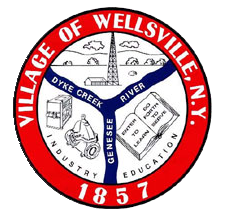From the Editor, 7/12/21
My and My Uncle, Bill Hendrick, a life long leader in Wellsville government and business, sat down with our good friend and extended family member Bill Whitfield for a talk suggested by Allegany County Historian Craig Braack. It is important for the reader to know that Whitfield is the current Director of the Department of Public Works for the Village of Wellsville, a 20 year veteran of the Department. Hendrick, was a citizen of Wellsville before the modern electric grid was installed. In the decades after that major upgrade, Hendrick served for decades in village government and worked directly with the “Water and Light Department”. Between the two guys, they know a thing or two about the subject.
The story starts back when Hendrick was a student at Wellsville High School before the village connected to the electrical system that is today the envy of many. At that time the village was provided electricity from a massive steam turbine housed in the village facility across from the high school. This massive turbine was used by the village with amazing efficiency in providing multiple public services. Much of that efficiency was probably why village leaders prior to Hendrick’s tenure installed the system: The turbine was manufactured in Wellsville by the Worthington Company, the predecessor of Turbodyne and Dresser-Rand. One can imagine the turbine must have been custom built and installed by the top steam engine experts in the nation. Maintenance and troubleshooting professionals were just across town.
Worthington’s turbine was about the size of a school bus and drew water directly from the river to be condensed into steam. That steam forced the turbine to produce enough electricity to power most of the village and produced enough excess steam to heat both the high school and the “Brooklyn” middle school. The steam was also used to heat many of the homes on the, “Brooklyn” side of town. Until the late 1950’s, that system provided electric to the average household, small grocery stores, schools, and the Main street district. Large operations like Worthington were not supported by the steam turbine powered Wellsville grid.
Maybe the most interesting part of the early municipal electric system has nothing to do with electric service. On the top of the building which housed the steam turbine was a steam whistle.
“It was so loud you’d have to cover your ears and it was blowing all the time. Every day at noon it would blow for lunch, it would blow at 6pm, and then it would blow for curfew at 9pm. If you were a kid in Wellsville and out on the streets, that whistle sent you running home,” Hendrick recalls.
But that wasn’t the only purpose the whistle served, this whistle was the heart of the Wellsville Fire Department alarm system. Since every single household in the village(and the town for that matter) could hear the whistle, our ingenious ancestors created a Morse code like system for sending out alarms. So well planned was this system that a volunteer fire fighter would hear the general alarm then wait for a corresponding location code before leaving the house to respond.
“They would blast out a fire signal, that told you whether it was in town or out of town. If it was an out of town fire, the firemen knew to head to the fire station and respond as a department. If they blew the ‘in town’ code, the firemen knew to wait for the location code. The whole village was mapped out in a grid that corresponded to the whistle blows. For example you’d hear three short blasts, followed by two long blasts and that meant the fire was on South Main Street. Every fireman had a chart at the ready to tell them where to respond as soon as the steam whistle blasted,” tells Hendrick.
Time marched forward and what seems to have been a brilliant way to provide utilities and fire protection services was changed forever in 1958. The New York State Power Authority was granted the rights to sell hydro-power under the Niagara Redevelopment Act. Shortly after, the Niagara Project Licensing Agreement was in place, paving the way for the electricity produced from Niagara Falls to be sold to across New York including certain municipalities in Western New York.
Wellsville was aptly situation to take advantage as a charter member of the Municipal Electrical Utility Association (MEUA), formed in 1930 to find solutions for municipalities growing demand for electric power. Two decades later, the foresight of Wellsville leaders paid off when the massive cheap power generator called Niagara Falls started ‘wheeling’ power south.
Has Hendrick recalls, the change from steam turbine electric to a modern, regional electric grid which generated power from one of the seven wonders of the world was smooth. A few years after plugging into Niagara Falls, the turbines stopped producing electric and only produced steam heat for the schools and “Brooklyn” side of town. Because the new source of electric was so economical, both schools and homes quickly installed technologies like electric base-board. The fire alert system also went the way of the dinosaur before too long, as ‘fireboxes’ were installed at every volunteers home.
Fast forward to 2021, and Bill Whitfield is looking back on a long career serving the village of Wellsville Department of Public Works. He started working with now retired Electric Superintendent Phil Hyer and then Assistant Director Bill Hanson (rest in peace), who are to be credited for helping bring the system into the modern technological age. The experience working with Hanson and Hyer, coupled with the knowledge gained from his many years at the Public Works Department since, make Whitfield the leading expert on this subject. In fact, his expertise and education is very widely drawn upon as the current President of the Municipal Electric Utilities Association Executive Committee. Ninety-one years after the village of Wellsville helped found the association, our Director of Public Works director is still at the forefront.
Bill Whitfield is happy to be quite junior to Bill Hendrick, and doesn’t have much first hand knowledge of the pre-modern system or its inception. Whitfield understands and has studied the history though, and applies that as part of his daily work. Being involved in the day-to-day of Wellsville’s public works since the days of Bill Hanson and Phil Hyer, the current director has seen the landscape change dramatically.
“When I took the job with the village we had two large manufacturing facilities on the grid and Riverwalk was fully occupied…. those customers drew a ton of power from the system. At one point I know we once maxed out at about 13 megawatts of usage. Today we might be at fifty percent usage during peak winter months,” Whitfield reports.
As it stands today, the Wellsville electric system is guaranteed a 10 megawatt allotment from the providers at the unbeatable price of 1/2 cent per kilowatt hour. Whitfield will tell you that price, coupled with an agreement locking in that rate until 2040 is the biggest asset Wellsville has today. “We are the envy of many in that regard,” reminds Whitfield.
The asset that many small towns can only dream of having, once again, has room for growth. With a 10 mega watt allotment and only about 4 to 5 mega watts of current average daily use, the village of Wellsville has a rare marketing opportunity at hand. “Only thirty nine other municipalities are members of this cooperative group, making us unique in New York State,” Whitfield explained. There are 534 villages in New York State, of which less than ten percent enjoy these electric rates.
The future of this tremendous asset could dictate the future of the entire village of Wellsville. Maintaining the infrastructure is expensive and requires lots of long term planning with both power providers and other networks like National Grid. Issues like solar power, electric vehicle charging stations, and recruiting the best staff possible are going to be challenges on top of the daily maintenance of this multi-million dollar village asset. Whitfield won’t be around for most of those challenges as he will retire at the end of the year.
Whitfield explained that over the past few years, the village has conducted several major upgrades to the system and dealt with several emergencies. In every instance, our longstanding relationship with the MEUA has been a key component. When a vehicle accident knocked out the “worst pole possible” this year, Wellsville could have been out of power for days had it not been for a mutual aid agreement between members of the MEUA. As the village upgrades key pieces of the hardware which transmits the electricity, engineers and technicians rely heavily on the planning and brain trust provided by the association. Read our previous reporting on that accident.
Whitfield maintains that the village having direct involvement in the MEUA organization is key to the stable future of our electric system. We have to continue to have a strong seat at the table within our larger network in order to give the taxpayer the best service possible:
“In countless instances that association has saved Wellsville money and will continue to do so. How we benefit from the larger electric grid that provides us our enviable source of power will be a function of how involved we are with the Municipal Electric Utility Association.”
This chat with the ‘two Bills’ revealed some great stories about the old days and some food for thought about the current state of the Wellsville village taxpayer’s biggest asset. Stay tuned to this channel for more about the future of the Department of Public Works and our prized electric supply.








